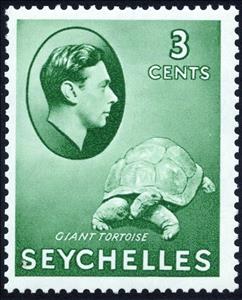Stamp: King George VI, Aldabra Giant Tortoise (Aldabrachelys gigant (Seychelles 1938)
King George VI, Aldabra Giant Tortoise (Aldabrachelys gigant (Seychelles 1938)
01 January (Seychelles ) within release Definitives goes into circulation Stamp King George VI, Aldabra Giant Tortoise (Aldabrachelys gigant face value 3 Seychellois cent
| Stamp King George VI, Aldabra Giant Tortoise (Aldabrachelys gigant in catalogues | |
|---|---|
| Michel: | Mi:SC 122 |
| Stamp Number: | Sn:SC 126 |
| Yvert et Tellier: | Yt:SC 119 |
| Stanley Gibbons: | Sg:SC 136 |
Stamp is square format.
Also in the issue Definitives:
- Stamp - King George VI, Aldabra Giant Tortoise (Aldabrachelys gigant face value 3;
- Stamp - Fishing canoe face value 6;
Stamp King George VI, Aldabra Giant Tortoise (Aldabrachelys gigant it reflects the thematic directions:
A head of state (or chief of state) is the public persona that officially represents the national unity and legitimacy of a sovereign state. In some countries, the head of state is a ceremonial figurehead with limited or no executive power, while in others, the head of state is also the head of government. In countries with parliamentary governments, the head of state is typically a ceremonial figurehead that does not actually guide day-to-day government activities and may not be empowered to exercise any kind of secular political authority (e.g., Queen Elizabeth II as Head of the Commonwealth). In countries where the head of state is also the head of government, the president serves as both a public figurehead and the actual highest ranking political leader who oversees the executive branch (e.g., the President of the United States).
Turtles are reptiles of the order Testudines, characterized by a special shell developed mainly from their ribs. Modern turtles are divided into two major groups, the Pleurodira (side necked turtles) and Cryptodira (hidden necked turtles), which differ in the way the head retracts. There are 360 living and recently extinct species of turtles, including land-dwelling tortoises and freshwater terrapins. They are found on most continents, some islands and, in the case of sea turtles, much of the ocean. Like other amniotes (reptiles, birds, and mammals) they breathe air and do not lay eggs underwater, although many species live in or around water.
King is the title given to a male monarch in a variety of contexts. The female equivalent is queen regnant (while the title of queen on its own usually refers to the consort of a king). In the context of prehistory, antiquity and contemporary indigenous peoples, the title may refer to tribal kingship. Germanic kingship is cognate with Indo-European traditions of tribal rulership (c.f. Indic rājan, Gothic reiks, and Old Irish rí, etc.) In the context of classical antiquity, king may translate Latin rex or either Greek archon or basileus. In classical European feudalism, the title of king as the ruler of a kingdom is understood as the highest rank in the feudal order, potentially subject, at least nominally, only to an emperor (harking back to the client kings of the Roman Empire). In a modern context, the title may refer to the ruler of one of a number of modern monarchies (either absolute or constitutional). The title of king is used alongside other titles for monarchs, in the West prince, emperor, archduke, duke or grand duke, in the Middle East sultan or emir; etc. Kings, like other royalty, tend to wear purple because purple was an expensive color to wear in the past.



